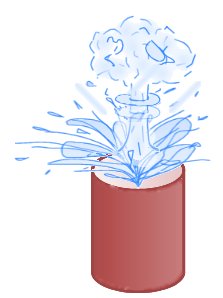Die Navier-Stokes-Gleichungen beschreiben die Bewegungen viskoser (dickflüssiger) Flüssigkeiten und Gase. Also das was man braucht, um zum Beispiel die Aerodynamik eines Flugzeugs zu modellieren.
Numerische Simulationen der Navier-Stokes-Geichungen sind oft sehr instabil.
Auch aus Theoretiker-Sicht sind selbst die grundlegendsten Fragen ungelöst: gibt es zu jedem Startwert eine “glatte” Lösung oder “explodiert” die Lösung? (Der mathematische Fachbegriff für solche Explosionen ist “blow up”.) Diese Frage ist eines der sieben mit einem Preisgeld von 1 Million Dollar ausgelobten Milleniumprobleme des Clay-Instituts.
Ein am Montag auf dem ArXiv erschienener Preprint “Finite time blowup for an averaged three-dimensional Navier-Stokes equation” von Terence Tao beweist nun, dass jedenfalls die Lösungen einer “gemittelten” Navier-Stokes-Gleichung explodieren.
Der “Nutzen” für das eigentliche Problem ist erstmal nur, dass damit verschiedene Ansätze zum Beweis der Existenz glatter Lösungen der Navier-Stokes-Gleichung von vornherein nicht funktionieren können. Aber es macht es vielleicht doch etwas wahrscheinlicher, dass auch die ursprünglichen Navier-Stokes-Gleichungen, also die Bewegungen von Flüssigkeit und Gasen explodieren könnten. Tao schreibt in seinem Blog:
There is a real (but remote) possibility that this sort of construction can be adapted to the true Navier-Stokes equations. The basic blowup mechanism in the averaged equation is that of a von Neumann machine, or more precisely a construct (built within the laws of the inviscid evolution {\partial_t u = \tilde B(u,u)}) that, after some time delay, manages to suddenly create a replica of itself at a finer scale (and to largely erase its original instantiation in the process). In principle, such a von Neumann machine could also be built out of the laws of the inviscid form of the Navier-Stokes equations (i.e. the Euler equations). In physical terms, one would have to build the machine purely out of an ideal fluid (i.e. an inviscid incompressible fluid). If one could somehow create enough “logic gates” out of ideal fluid, one could presumably build a sort of “fluid computer”, at which point the task of building a von Neumann machine appears to reduce to a software engineering exercise rather than a PDE problem (providing that the gates are suitably stable with respect to perturbations, but (as with actual computers) this can presumably be done by converting the analog signals of fluid mechanics into a more error-resistant digital form). The key thing missing in this program (in both senses of the word) to establish blowup for Navier-Stokes is to construct the logic gates within the laws of ideal fluids. (Compare with the situation for cellular automata such as Conway’s “Game of Life“, in which Turing complete computers, universal constructors, and replicators have all been built within the laws of that game.)



Kommentare (11)